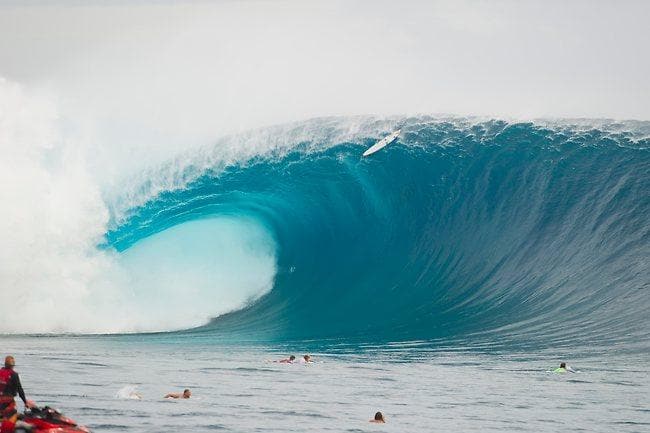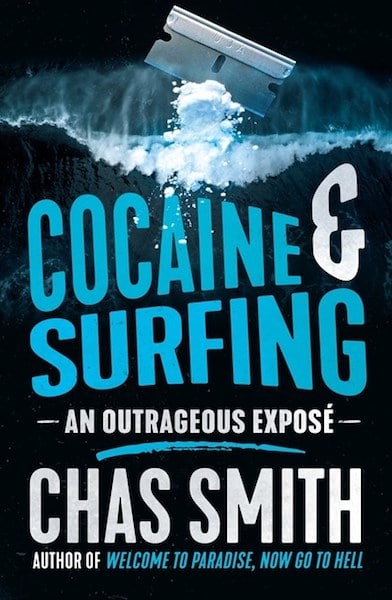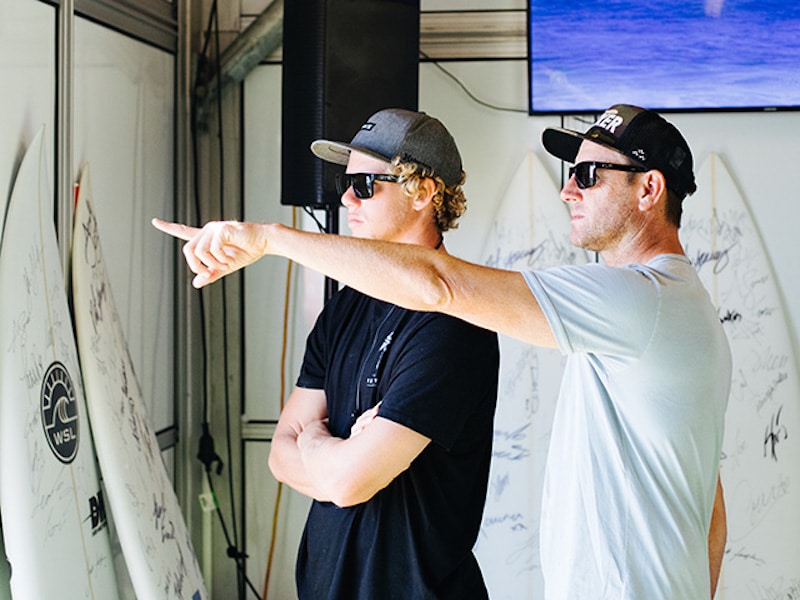And challenges Gabriel Medina to fight!
Day five, six, whatever it is caught me on the hop. Women’s heats called on, and it’s not that I’m not interested in womens Pro Surfing – my plan is to transition into full-time coverage and ditch the mens – but after thinking and focussing on pro surfing so much a sportswriter needs some clean air away from the screen. ie. the waves were pumping here.
The notification came half way through heat one round four. But first should we riff a little more on John Florence? Does his year not recall that famous quote from Hemingway’s The Sun Also Rises, “How did you go broke?”
“Slowly at first, then all at once.” Paraphrase, I know.
We’ve failed, so far, to attribute any of the blame to mere randomness, what author Nassim Nicolas Taleb calls the “Black Swan event.” His first loss to Mikey Wright (at Snapper) just occurred from a slightly too sleepy start in a heat where the best waves came to Mikey.
Then at Bells, he was hassled off the first wave by Zeke Lau and over-compensated with patience.
Margarets he is still going and here in Bali he again suffered a slightly too sleepy heat against an unfancied opponent who threw caution to the wind and prevailed.
Surf journalist Nick Carroll in comments said he could have walked to his second title last year except for a relapse in heat strategy. I see it slightly differently. He was on fire at Bells and should have won his heat against an over-scored Ibelli. Same in J-Bay against Morais. Again, luck: randomness. The subjectivity of judges. If those two events went his way, the title would have been won far sooner.
I don’t believe he wants to walk away.
Why?
My short but intensive interviews with him revealed a man of surprising competitive intensity. I take at face value his claims to want to win big by going bigger and redrawing the boundaries of competitive surfing. I believe that is sufficient motivating force for him to be on tour.
But he’s been mugged by the reality of randomness. So far. Problem is now plugging the holes so the losing slowly, heat by heat, doesn’t begat the catastrophe of losing the whole year in a torrent of uncontrolled bad heats. J-bay, more than Ulus, offers a reset.
Four heats today, in perfect high-perf conditions. Bourez masterful, masterful rail lord in heat one.
Heat two was a banger. Ace out of the blocks quickly, Mikey looked hesitant and slow. Griff patient. In the back third Ace’s lead was reversed as Mikey caught fire then Griff bought full repertoire from rail game to fins out surfing. One thing to note: Mikey has been unable to score using hi-fi surfing and has had to “backpeddle” to the rail game. If he meets Filipe that will be telling. Wright and Colapinto through.
Jordy stole away from Flores and Medina in heat three to open a slender lead with very big opening turns. Medina looked beastly, again. But could not finish a wave properly to ice a lead. J-Flo played patient tube hound and rode the best waves of the heat. The heat pivoted on a paddle battle with three minutes to go. Jordy greased a slick air, kicked out in front of Gabe, then went toe-to-toe with Medina in a physical paddle battle. I was stunned Jordy won that. Absolutely pole-axed. That left Medina last priority as the clock ticked down and a heat loss he will bitterly rue come year’s end.
“This really fired me up,” said Jordy in the post-heat presser with Kaipo Guerrero. “We were paddling and he pulled my leg once and I went, ok accident, twice, I thought that’s deliberate. Put em up. Let’s go.”
“Love it, love it, that passion,” muttered a panicked Kaipo, echoes of Todd Kline’s interview with Bobby Martinez in 2011.
Jordy had just said, on a live webcast, that he’d been deliberately interfered with by Medina and that he’d subsequently suggested they fight.
No follow-up question. No investigation. No probing.
“Can you carry that passion into the quarter-final?” said Kaipo.
Yawn.
The final matchup with Italo, Filipe and ADS was a slight, slight anti-climax. Not for aficionados of backside surfing because Italo showed the game has changed and he is at the apex of high performance surfing, not John, not Filipe.
It was slight anti-climax because he skipped away so quickly and with so much dominance that it was no contest. He too, can not quite grease one of the towering airs he’s been attempting. If he sticks one, the dam wall will burst. If Australia can support thrre CT’s an actual Bali leg should be a no-brainer, even if the tech billionaires who now seem to control Big Surfing are enthralled with trains in tubs.
We’ll meet again tomorrow for the final, I guess.
Corona Bali Protected Men’s Round 4 Matchups:
Heat 1: Michel Bourez (PYF) 17.00 def. Willian Cardoso (BRA) 13.60, Jesse Mendes (BRA) 11.66
Heat 2: Mikey Wright (AUS) 15.80 def. Griffin Colapinto (USA) 13.73, Adrian Buchan (AUS) 12.50
Heat 3: Jordy Smith (ZAF) 11.76 def. Jeremy Flores (FRA) 11.70, Gabriel Medina (BRA) 10.76
Heat 4: Italo Ferreira (BRA) 17.00 def. Filipe Toledo (BRA) 13.87, Adriano de Souza (BRA) 13.16
Corona Bali Protected Men’s Quarterfinal Matchups:
Heat 1: Michel Bourez (PYF) vs. Griffin Colapinto (USA)
Heat 2: Mikey Wright (AUS) vs. Willian Cardoso (BRA)
Heat 3: Jordy Smith (ZAF) vs. Filipe Toledo (BRA)
Heat 4: Italo Ferreira (BRA) vs. Jeremy Flores (FRA)








